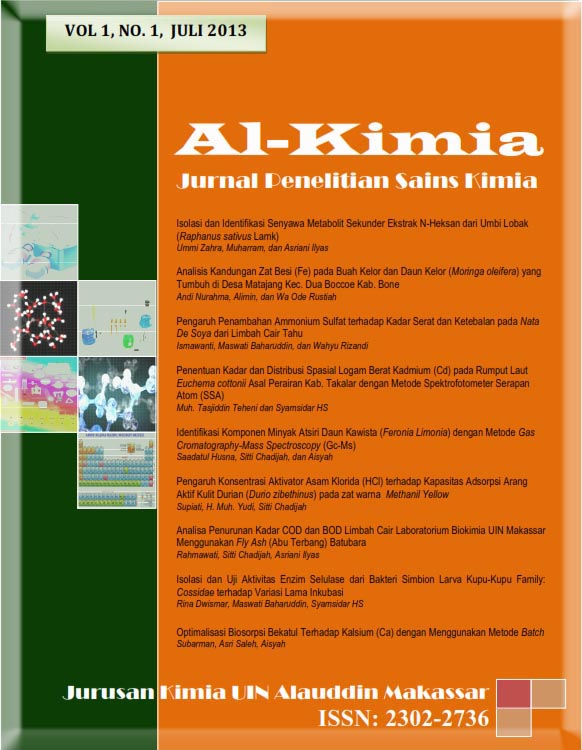Pengaruh Penambahan Ammonium Sulfat Terhadap Kadar Serat dan Ketebalan pada Nata de Soya dari Limbah Cair Tahu
Abstrak
The research aimed to know the production of cellulose in tofu liquid waste, the effect of adding ammonium sulfate to the nata de soya, and the quality nata de soya produced from Tofu Liquid Waste. The parameters used are the determination of the thickness and weight, measure of water, and fiber test of nata de soya. By using variations of the addition of ammonium sulfate 10 g, 15 g, 20 g, and 25 g. 35 grams of sugar in 500 mL of tofu liquid waste, starter bacteria Acetobacter xylinum as much 100 mL, and fermented for 14 days at a temperature of 28-30oC. The quality nata de soya highest of the addition 15 grams of ammonium sulfate with a thickness of 1.7 cm, weight 231.0 grams, the lowest water content of 94.23% and the highest fiber content of 2.41%.
##plugins.generic.usageStats.downloads##
Referensi
Bintang, M., 2010, Biokimia Teknik Penelitian, Jakarta: Erlangga.
Dewi, S., 2009, Pengaruh Jenis Gula dan Lama Inkubasi Terhadap Kualitas Nata De Milko Ditinjau dari Serat Kasar, Rendamen, dan Kadar Air, Skripsi, Malang:Fakultas Peternakan Brawijaya.
Djajati, S., Sarofa, U., dan Syamsul A. Pembuatan Nata De Manggo (Kajian: Konsentrasi Sukrosa dan Lama Fermentasi). Laporan hasil Penelitian Pusat Penelitian UPN “Veteran,” Jawa Timur.
Edria, D., Wibowo, M., dan Elvita K, Pengaruh Penambahan Kadar Gula dan Kadar Nitrogen Terhadap Ketebalan, Tekstur dan Warna Nata De Coco, Laporan Hasil Penelitian, Bogor: Pusat Penelitian IPB.
Hastuti, B. dan Hadi, S., 2009, Pengaruh Penambahan Konsentrasi Gula Terhadap Kualitas Nata De Soya dari Limbah Cair Tahu, Laporan Hasil Penelitian, Yogyakarta: Pusat Penelitian UNY.
Macklin, B., 2009, Limbah Tahu Cair Tahu Menjadi Biogas, Bandung: Universitas Padjadjaran, (Online), http:/www.onlinebuku.com, diakses pada 15 Juni 2011.
Muzhoffar, B., 2000, Isolasi Bakteri Acetobacter Xylinum dari Media Cair Fermentasi, Laporan Hasil Penelitian, Sumatera Utara: Pusat Penelitian USU
Nurika, Hidayat, I. N., dan Anggraeni, Y., 2007, Produksi Selulosa Menggunakan Kultur Kombucha Dari Limbah Cair Industri Tahu (Kajian Penambahan Sukrosa Dan Amonium Sulfat Serta Analisis Biaya Produksinya). Jurnal Teknologi Pertanian, vol, 8 No.2, http://isjd.pdii.lipi.go.id, diakses pada 10 Oktober 2012.
Pohan, N., 2008, Pengolahan Limbah Cair Industri Tahu dengan Proses Biofilter Aerobik, Tesis, Medan: Sekolah Pasca Sarjana Universitas Sumatera Utara, Medan.
Pusat Penelitian IPB, 2005, Acetobacter Xylinum, Laporan Hasil Penelitian, Bogor: Pusat Penelitian IPB.
Pusat Penelitian USU, 2000, Pembuatan Nata De Coco, Laporan Hasil Penelitian, Sumatera Utara: Pusat Penelitian USU.
Putra, B. P., 2008, Karakteristik Selulosa Bakteri, Laporan hasil penelitian Pusat Penelitian USU, Sumatera Utara.
Sudarmadji, S., Haryono, B., dan Suhardi, 1997, Prosedur Analisa Untuk Bahan Makanan dan Pertanian, Yogyakarta: Liberty.
Sulistyowati, E., dan Salirawati, D., 2008, Pembuatan Nata dari Limbah Buah-buahan sebagai Alternatif Keaneka-ragaman Makanan, (Laporan hasil penelitian Pusat Penelitian FMIPA UNY, Yogyakarta, 2008), h. 19-20.
Winarno F. G., 2004, Kimia Pangan dan Gizi, Jakarta: PT. Gramedia Pustaka Utama.
Yuniarba, A. F., Karbohidrat, (Makalah Biokimia yang disajikan pada Kementrian Pendidikan Nasional di Universitas Brawijaya, Malang, 27 Maret 2012).
Authors who publish with this journal agree to the following terms:
1) Authors retain copyright and grant the journal right of first publication with the work simultaneously licensed under a Creative Commons Attribution License that allows others to share the work with an acknowledgement of the work's authorship and initial publication in this journal.
2) Authors are able to enter into separate, additional contractual arrangements for the non-exclusive distribution of the journal's published version of the work (e.g., post it to an institutional repository or publish it in a book), with an acknowledgement of its initial publication in this journal.
3)Authors are permitted and encouraged to post their work online (e.g., in institutional repositories or on their website) prior to and during the submission process, as it can lead to productive exchanges, as well as earlier and greater citation of published work (See The Effect of Open Access).


